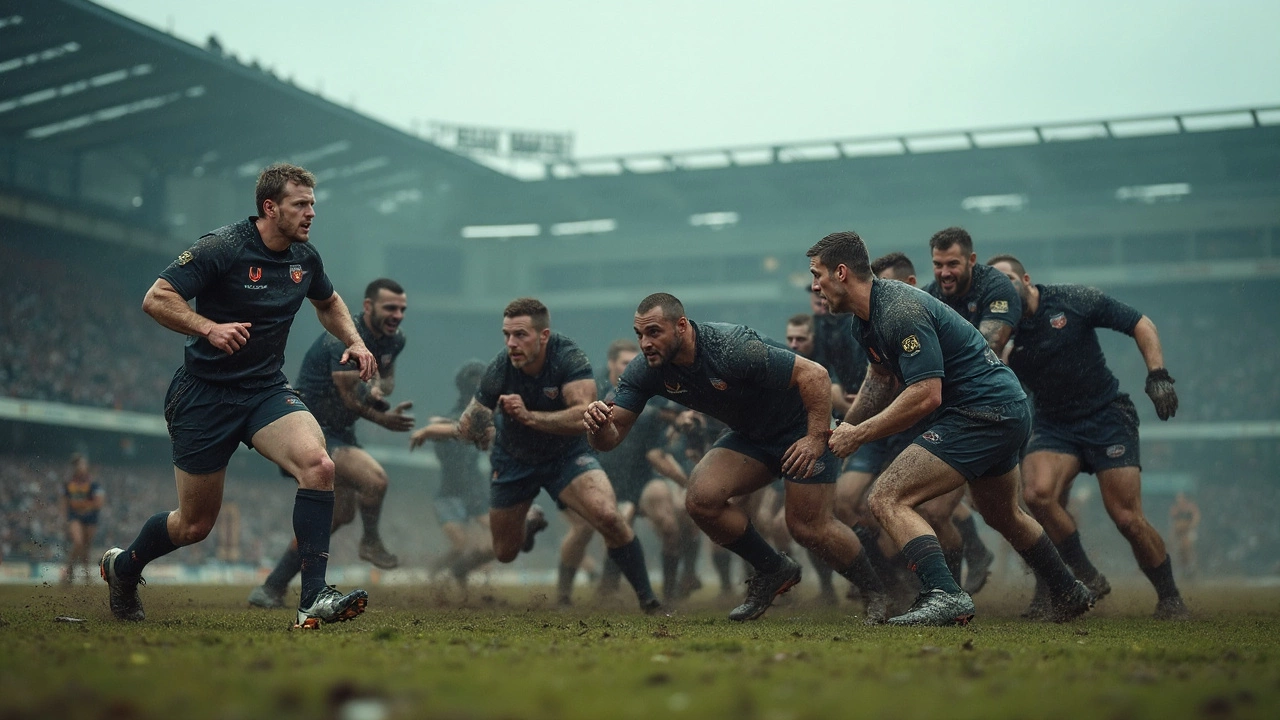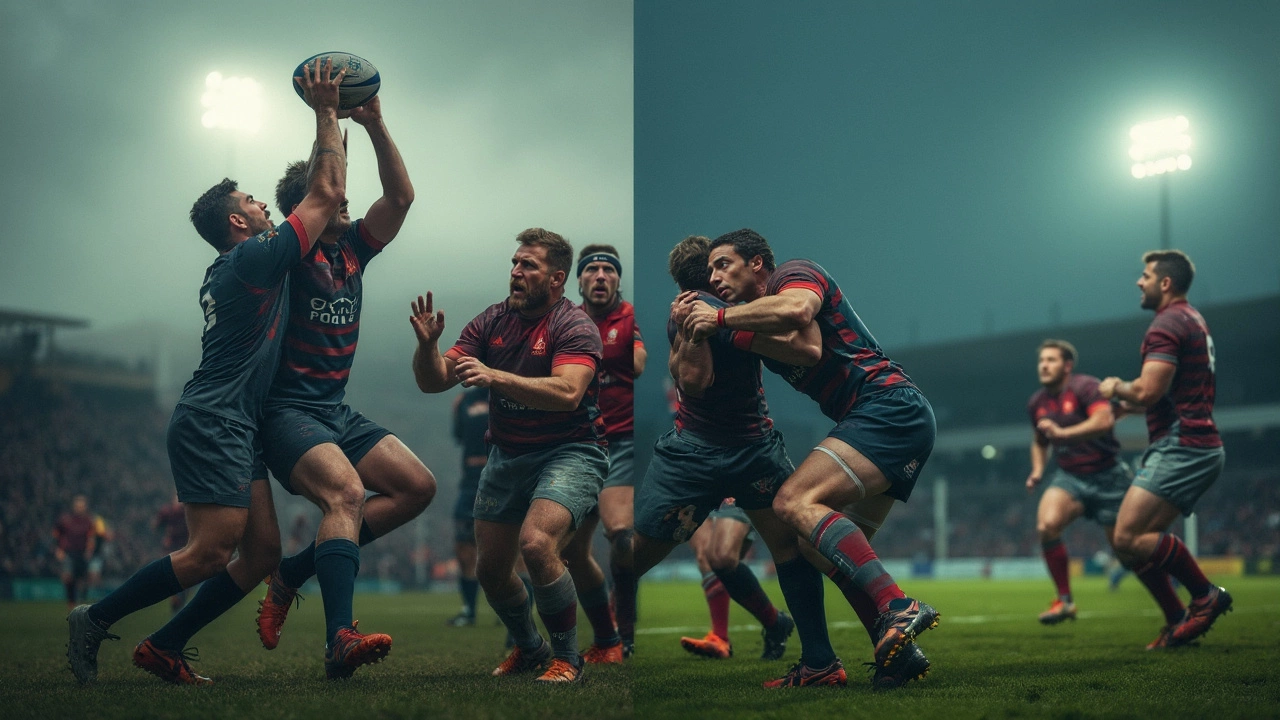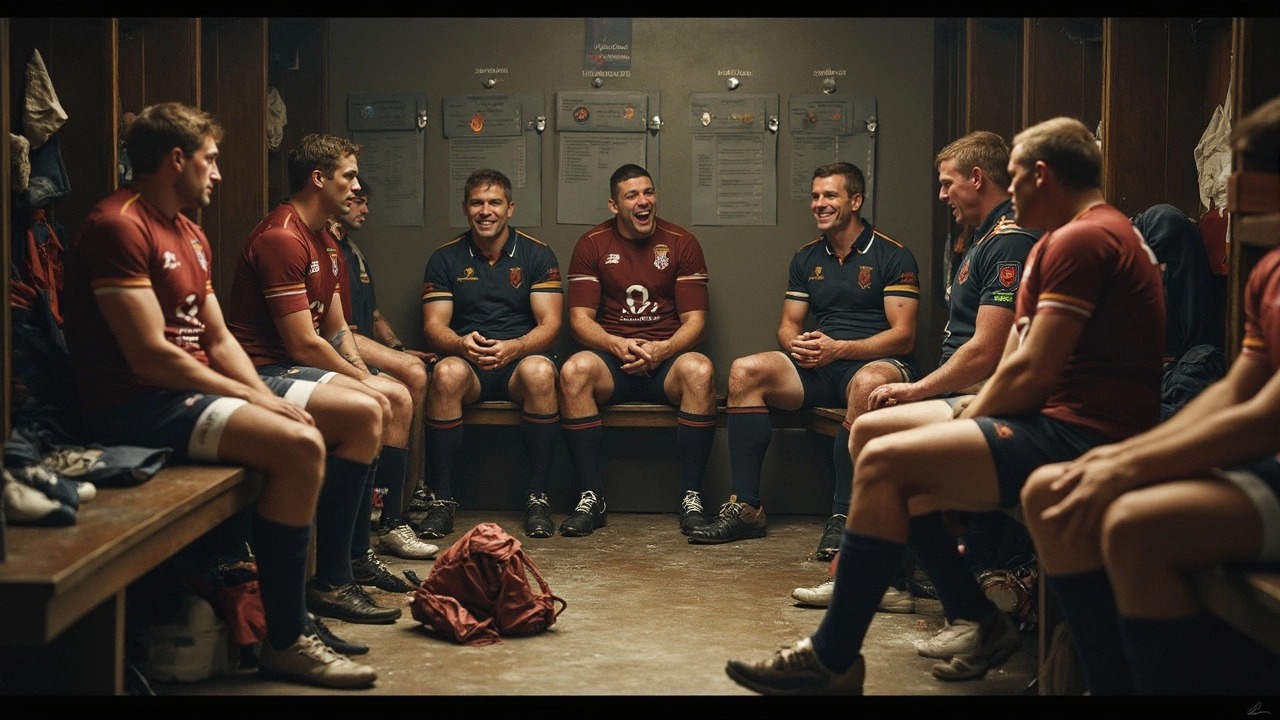
If you ask a group of die-hard rugby fans which is tougher—league or union—you’ll start a pretty heated debate. Both games look similar to an outsider: big guys smashing into each other, brutal tackles, players running themselves into the ground. But scratch a little deeper and you’ll spot the differences in speed, rules, and what really takes a toll on the body.
Rugby league is known for its fast pace and relentless tackles, while union has more scrums and all-out contests for the ball. Ever noticed the battered faces after a Super League or Six Nations match? That's not just for show. Each code pushes players in unique ways, and to really understand which is tougher, you need to know how the rules, hits, and recovery stack up. Stick around—we’ll break it down so you can settle the argument next time you’re chatting rugby fixtures at the pub.
- Breaking Down the Basics: League vs Union
- Tackling, Hits, and On-Field Hits
- Training, Recovery, and Injuries
- Mental Toughness and Game Strategy
- Player Tips: Choosing Your Code
Breaking Down the Basics: League vs Union
To settle the "which is tougher" debate, you first need to get your head around what actually separates rugby league from union. They share a rugby ball and big hits, but that’s about where the similarities end.
Let’s get the numbers straight. Rugby league teams have 13 players on the field, while union goes with 15. That little difference changes how much running each player does, which gaps open up, and how tired you get after a set. In league, tackles work on a six-tackle rule—after the sixth, you hand over the ball. Union? Play resets with rucks, mauls, and scrums, so the game has more stops and starts.
| Aspect | Rugby League | Rugby Union |
|---|---|---|
| Players per Team | 13 | 15 |
| Main Restart | Set after six tackles | Rucks, mauls, scrums |
| Average Ball-in-Play Time (per 80 mins) | 55 mins | 40 mins |
Notice that league games have more ball-in-play action—on average 15 minutes more compared to union. That means less standing around and more running. The pace stays high and mistakes get punished quickly, keeping everyone switched on.
Union packs more players into set-pieces. Scrums, lineouts, and rucks involve every forward, and it gets messy and physical in a different way than open-field play. That’s where you see those monster props and locks earning their paycheck. In league, there are fewer set-pieces and more open play, so speed and endurance are even bigger factors.
If you’re thinking about switching codes (or just understanding what you’re watching), remember: the basics shape everything else. League is built for speed, endurance, and brutal tackling. Union is all about strategy, set-piece strength, and staying tough through long, punishing phases.
Tackling, Hits, and On-Field Hits
Fans always talk about the big hits during a rugby league or union match, but there’s a real difference in how those tackles go down. In league, you get six tackles before you have to hand over the ball. That leads to a faster pace and a ton of high-intensity tackles—some games average over 300 tackles per side, which is wild. The defense gets barely any time to reset, so each hit is direct and often more punishing on tired bodies.
Union is a bit different. There’s no tackle count, so after a player is brought down, it’s a scramble for the ball, often leading to big pile-ups called rucks. Here, the contest is brutal, but it’s not just about the impact—it’s about fighting for the ball, pushing, and using every bit of strength. Try watching back-to-back Six Nations matches—those guys sometimes spend more time in rucks than running free, working through heaps of body-on-body action.
Now, if you want numbers: according to a 2023 UK study, the average league player makes around 25 to 40 tackles per match, while in union, it clocks in slightly lower at 15 to 30. However, the average union tackle tends to involve multiple players, which changes the kind of punishment bodies absorb.
| Code | Average Tackles per Player | Type of Contact | Most Common Injury |
|---|---|---|---|
| Rugby League | 25–40 | Front-on, rapid | Shoulder/Arm |
| Rugby Union | 15–30 | Ruck/Maul, multi-player | Knee/Lower Leg |
The tackling technique matters too. League players aim for legs or midsection and pride themselves on textbook hits. Union players sometimes have to go high or pile in during mauls and rucks, where head clashes and twisted limbs aren’t rare.
- If you’re playing league, you need killer technique to survive the sheer number of tackles.
- If you’re into union, you better be strong enough to handle the chaos of scrums, rucks, and mauls where bodies crash together from all angles.
Bottom line: league gives you non-stop hits, while union offers more variety in how your body gets worked over. If you’re deciding which code to play, ask yourself—do you want constant one-on-one collisions or the unpredictable storm inside a ruck?

Training, Recovery, and Injuries
No matter if you’re talking rugby league or union, the training demands are brutal. But here’s where they split: league players focus more on speed, cardio, and repeat sprinting because their game just doesn’t stop. A league training week will usually smash through shuttle runs, explosive power work, and heaps of full-contact drills. Union guys, on the other hand, spend serious time on scrummaging and lineout technique. They do plenty of strength work, but set-piece practice is a lot more technical and slows things down during some sessions.
Injuries? Sadly, both codes are a minefield. Contact is constant in both, but the injury profiles differ. League has more muscular injuries because of the stop-start nature and sprinting. Meanwhile, union leads to more concussions and joint injuries, thanks to rucks and all that pile-on tackling. The recent World Rugby study in 2023 showed concussion rates in union nearly double those in league – about 2.1 concussions per 1000 player hours vs 1.2 in league.
| Injury Type | Rugby League | Rugby Union |
|---|---|---|
| Concussions (per 1000 hours) | 1.2 | 2.1 |
| Muscle Strains | High | Medium |
| Knee/Ligament Injuries | Medium | High |
| Dislocations | Medium | Medium |
When it comes to recovery, both sets of players use ice baths, stretching, and a ton of physio. But the jam-packed fixture list in league means less time for recovery, and guys often play through pain. A typical NRL or Super League player can expect up to 28 regular season games; top union players might play fewer but with more rest weeks thanks to international windows and club commitments split up over a longer calendar.
- Always listen to your physio and communicate honestly, no heroics when you’re sore.
- Nutrition matters: league players often lean towards higher carb intake for energy, union guys go big on protein to recover from heavy contact and scrummaging.
- Stick to your rehab plan if you get injured—coming back too soon just wrecks your body long-term.
So, if you ever wonder why these blokes limp away looking ten years older after a season, now you know. Toughness? Both codes test it in different ways, but staying fit isn’t just about heart—it’s about smart training and even smarter recovery.
Mental Toughness and Game Strategy
Mental strength is where things really get interesting. In rugby league, players have to keep their focus through fierce sets that repeat every few minutes. After six tackles, the pressure’s on—kick the ball, lose ground, or pull off a miracle play. Fatigue messes with your mind as much as your body, so staying sharp when your lungs are burning is a must.
Rugby union challenges your brain differently. The game is full of stops and re-sets: scrums, lineouts, rucks, and mauls. Every restart is loaded with tactical options. Players are always thinking—do you drive the ball, try a clever kick, or switch up the direction? Top teams change strategy mid-match based on what’s working. Some calls come straight from the fly-half on the field, others get relayed through headsets from coaches. It’s mental chess, not checkers.
Just for a taste, here’s a quick look at how much thinking and adapting goes on during a match:
| Code | Typical On-Field Decisions | Average Restarts per Game | Key Mental Challenge |
|---|---|---|---|
| Rugby League | Set plays, kick choices, defensive line calls | ~30 | Pace, high pressure after each tackle set |
| Rugby Union | Scrum tactics, lineout calls, breakdown decisions | Over 60 | Reading game flow, switching strategies |
One famous study on international players in 2023 found that union players spend nearly 30% of match time discussing or executing on-field tactical plans, while league players are forced to react and adapt much faster between tackles. Both mental strains are different beasts, each with major burnout risk if you lose your head under pressure.
Want to train your brain for rugby? Try these tips:
- Simulate match conditions: practice drills that mix physical fatigue with quick decision-making.
- Work with a coach on scenario planning—"what if" situations come up in every fixture.
- Watch pro matches and pause before big plays. Guess the decision, then see what actually happens.
- Stay positive after mistakes. Mental reset gets easier with practice.
Both games will call out any mental weakness. The cleverest players, not just the toughest, make game-winning moments happen.

Player Tips: Choosing Your Code
If you’re wondering whether you belong in rugby league or rugby union, the choice isn’t just about picking the one that looks tougher on TV. It’s really about knowing your strengths, fitness level, and where you find the most fun. Each code has its unique hits, pace, and tactics.
- Pace and Fitness: League is nonstop. The ball’s in play more, there are fewer stoppages, and you’re running all the time. If you’ve got a huge engine and love quick plays, you’ll fit right in.
- Physical Grit: Both codes have huge collisions, but union’s rucks, mauls, and scrums mean heavy wrestling and close-quarters muscle. You’ll want some extra bulk if the thought of repeated scrum time excites you.
- Skillset: Union needs tight technical work—think lineouts and set pieces—along with open-play action. League is more about support play, one-on-one tackles, and sharp passing under pressure.
- Injury Patterns: According to a 2023 injury report, league players had a slightly higher risk of concussions (6 per 1000 hours) compared to union (5 per 1000 hours), but muscle strains were more common in union, especially among forwards. Think about where you’re more resilient: the constant heavy running, or the stop-and-go, wrestle-heavy bursts.
Still unsure? Check what’s available locally. Some areas are league-strongholds (like northern England or parts of Australia), while others live and breathe union. Also, look at your desired position—wingers in league might barely see a scrum, whereas union wings end up rucking and tackling plenty.
| Factor | Rugby League | Rugby Union |
|---|---|---|
| Average Ball-in-Play Time (Per Game) | 55 minutes | 35 minutes |
| Average Tackles Per Game (Per Player) | 25-35 | 8-15 |
| Primary Injuries | Concussions, shoulder injuries | Muscle strains, knee injuries |
| Required Skill Focus | Endurance, tackling, support play | Technical (set-pieces), strength, tactical awareness |
The best tip? Try both in training. Most clubs welcome newcomers regardless of experience. Talk to current players about what surprised them most. Stick with whichever style you walk away from feeling exhausted, but already itching to go again.